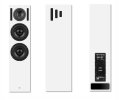Pošteno je biti skeptičan prema skupom proizvodu. Osobno mislim da se Saranna lako natječe sa dvostruko skupljim zvučnicima. Pokušat ću objasniti najbolje što mogu.
kardioid:
Uobičajena zabluda o kardioidu je da poništava refleksije od zida, ali to nije ono što se događa. Zvučni valovi koji dolaze iz drajvera su poništeni/oblikovani izvanfaznim zvukom koji emitira bočne otvore. To znači da zvuk uopće ne dolazi do zida. Manje zvuka se šalje iz zvučnika u bočnom i stražnjem smjeru. To znači da je učinkovit bez obzira na udaljenost od zidova.
Cijena:
Zašto pretpostavljate da koristimo jeftini MDF?

Radi se o MDF-u za glodanje koji je po gustoći bliži HDF-u. Ili misliš da je MDF jeftin materijal? Još je jedna uobičajena zabluda da je glavni razlog troška proizvoda trošak materijala ili komponente. Komponente su naravno značajan trošak, kao nasumični primjer, možete kupiti subwoofere od 12" u trgovini koji koštaju manje od cijene samog drajvera od 12" od naših subwoofera. Vozač nije samo vozač.
Osim toga, postoji mnogo drugih stvari koje također doprinose trošku. Uvjeravam vas da su naše marže niže od uobičajenih u industriji. Mogu navesti nekoliko stvari koje čine vođenje posla, bez posebnog redoslijeda, gdje je cijena materijala/komponenti samo jedna:
- Pakiranje
- Dostava kupcu
- Uvozne takse i PDV (mi ih plaćamo za kupca)
- Istraživanje i razvoj (simulacija, CAD crteži, izrada prototipova, nabava komponenti, testiranje/slušanje, mjerenja itd. Razvoj Saranne započeo je u studenom 2023.)
- Povrati, jamstva, štete prilikom dostave
- Najam / Objekti / Skladište
- Marketing i oglašavanje
- Porezi
- Plaćanje radnih sati/osoblja, bilo zaposlenika ili konzultanata
- Komponente i materijali
- Dobit
- itd...
Završna obrada drveta:
Kažete da nema drvene završne obrade, ali naprotiv, koristimo pravi kompozitni drveni furnir iz talijanskog Alpija.
Komponente križanja:
Pitate o komponentama skretnice. Nema komponenti skretnice jer su zvučnici aktivni. Što znači da imate tri Hypex modula pojačala u svakom zvučniku. Kupnja pasivne alternative i zatim kupnja vanjskih pojačala također nije besplatna.
Gdje je proizvodnja:
- Sav rad na dizajnu i razvoju odvija se u Norveškoj.
- Zvučnici se sastavljaju i testiraju (svaki zvučnik se mjeri i spaja par unutar +/1dB od 100-10,000 Hz) u Norveškoj.
- Zvučnici su uskladišteni i otpremljeni iz Norveške.
- Koaksijalni drajver prilagođena je verzija OEM modela tvrtke Sica i proizvodi se u Italiji
- Basovi su iz Wavecora, koji ima danske vlasnike, ali proizvodi u Kini
- Ormari su izrađeni i obojani/furnirani prema najvišim standardima u Estoniji
- Furnir je iz Italije
- Pojačala/DSP moduli su iz Hypexa sa sjedištem u Nizozemskoj, ali proizvode u vlastitom pogonu u Maleziji.
- Noge za prigušivanje po narudžbi proizvodi Egeland acoustics u Norveškoj
Nadam se da će ovo donekle odgovoriti na vaša pitanja.
